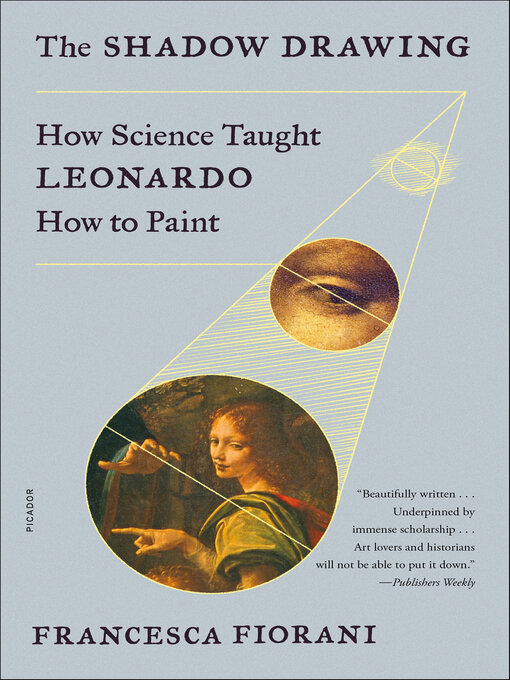A New York Times Book Review Editors' Choice
Shortly after Leonardo da Vinci's death, his peers and rivals created the myth of the two Leonardos: there was Leonardo the artist and then, later in life, Leonardo the scientist. In this pathbreaking biographical interpretation, the art historian Francesca Fiorani tells a very different and much more interesting story.
Taking a fresh look at Leonardo's celebrated but challenging notebooks and other sources, Fiorani shows that Leonardo became fluent in science when he was still young man. As an apprentice in a Florence studio, he was especially interested in the science of optics. He aspired to use this knowledge to capture—as no artist before him had ever done—the interior lives of his subjects, to paint the human soul in its smallest, tenderest motions and vicissitudes. And then he hoped to take one further step: to gather his scientific knowledge together in a book that would be even more important than his paintings. In The Shadow Drawing, Fiorani revises our understanding of Leonardo the artist's most renowned paintings and reconstructs the wisdom Leonardo the author hoped to impart. The result is both a stirring biography and a bold reconsideration of how the Renaissance understood science and art—and of what was lost when the two were sundered.
"Fiorani's lively intellectual adventure gives us new understanding and appreciation of Leonardo's cross-fertilization of art and science. It is a perceptive biography of Leonardo exploring the frontiers of science but also a brilliantly informative guide to his paintings." —Ross King, author of Brunelleschi's Dome, Leonardo and the Last Supper, and Mad Enchantment
-
Creators
-
Publisher
-
Release date
July 2, 2024 -
Formats
-
Kindle Book
-
OverDrive Read
- ISBN: 9780374715298
-
EPUB ebook
- ISBN: 9780374715298
- File size: 28234 KB
-
-
Languages
- English
-
Reviews
-
Kirkus
November 1, 2020
The science of light and shadow illuminates Leonardo da Vinci's revolutionary art. University of Virginia art historian Fiorani's sparkling second book explores how Leonardo's love of science informed his art. Intimately capturing the artistic, religious, and cultural landscape of Leonardo's world, the author traces his development as an artist from his early apprenticeship days to the lessons he learned as he painted his greatest works and up to his posthumous legacy. In his book The Lives, Giorgio Vasari's influential portrait of Leonardo "discredited" Leonardo's "science of art," ruining Leonardo's reputation for years. Throughout, Fiorani's detailed attention to Leonardo's notebooks show how much his interests in art and science were interwoven. He produced a handful of paintings, many unfinished, but some 4,100 notebook pages filled with notations, sketches, and technical and shadow drawings. The author notes that in his late 30s, Leonardo's interest in the world of art shifted to focus on science and philosophy, especially optics and the "subtle pattern of shadows" on objects. His earliest works were studies of drapery, and his innovative Florentine teacher, Andrea del Verrocchio, taught him to "carefully observe each fold and to capture the effect of shifting light." Fiorani effectively describes Leonardo's experiments with paints that allowed him to "achieve an astounding variety of optical effects" in his first solo painting, the Annunciation. With his "stunning" portrait Ginevra, he aspired to capture not just a young woman's beauty, but also her soul and a "new way of painting." Adoration, which he left unfinished, "forced him to rethink what he knew and did not know about the science of optics" while Virgin of the Rocks was a "masterpiece of optics." Last Supper, which began to deteriorate shortly after he finished it, is "perhaps the saddest example of Leonardo pushing experimentation too far." Mona Lisa remained unfinished as well. An absorbing inquiry into a legendary artist and his techniques.COPYRIGHT(2020) Kirkus Reviews, ALL RIGHTS RESERVED.
-
Publisher's Weekly
November 23, 2020
Fiorani (The Marvel of Maps), an art historian at the University of Virginia, provides new insight into the work of Renaissance master Leonardo da Vinci in this fresh assessment. She examines Leonardo’s training in the Florence workshop of Andrea del Verrocchio and his study of the science of optics before moving on to a technical analysis of Leonardo’s major works, showing how he applied his scientific learning when creating The Last Supper and the Mona Lisa. Using information gleaned from infrared reflectography and X-ray fluorescence spectroscopy done on Leonardo’s paintings, Fiorani leads readers through the artist’s tortuous re-working of his art. “The secret of the Mona Lisa’s smile,” she notes, is created by the application of “multiple layers of colors and varnishes with low atomic density.” It also becomes clear that Leonardo “understood that the subtlest change of heart or mind involuntarily triggered an alteration in the appearance of bodies and faces” and thus saw painting as “a technique for revealing the human soul.” This beautifully written work is underpinned by immense scholarship; art lovers and historians will not be able to put it down.
-
Formats
- Kindle Book
- OverDrive Read
- EPUB ebook
subjects
Languages
- English
Loading
Why is availability limited?
×Availability can change throughout the month based on the library's budget. You can still place a hold on the title, and your hold will be automatically filled as soon as the title is available again.
The Kindle Book format for this title is not supported on:
×Read-along ebook
×The OverDrive Read format of this ebook has professional narration that plays while you read in your browser. Learn more here.


